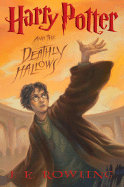
 Rest assured, there are no spoilers in this review. It is hard to imagine a book more highly anticipated than this one, and yet it meets--and even surpasses--all expectations. As Rowling's final episode opens, Harry is about to turn 17, at which point his mother's "protective charm . . . will break," just as Voldemort and the Death Eaters begin to dominate the Ministry. In a trajectory that began with Order of the Phoenix, the hero's internal journey takes precedence over the external journey--though there is plenty of action in these nearly 800 pages.
Rest assured, there are no spoilers in this review. It is hard to imagine a book more highly anticipated than this one, and yet it meets--and even surpasses--all expectations. As Rowling's final episode opens, Harry is about to turn 17, at which point his mother's "protective charm . . . will break," just as Voldemort and the Death Eaters begin to dominate the Ministry. In a trajectory that began with Order of the Phoenix, the hero's internal journey takes precedence over the external journey--though there is plenty of action in these nearly 800 pages.Like Harry before him, Dumbledore here becomes the subject of a smear campaign, and the young hero must tease out the truth. He entertains the notion that crosses most students' minds: "Never once had he imagined Dumbledore's childhood or youth; it was as though he had sprung into being as Harry had known him, venerable and silver-haired and old." Because readers progressed along with the maturing Harry, they gained the knowledge required for his quest right along with him, and not a moment before it was needed. Here, as Harry makes a pilgrimage to many of the sites of greatest importance throughout the series, he learns some difficult truths about himself. Characters from as far back as Griphook, the goblin at Gringotts, and Tom, the bartender at the Leaky Cauldron, plus house-elves Kreacher and Dobby choose up sides, as all roads lead to the inevitable showdown between Harry and You-Know-Who.
Their contest turns out to be intricately connected with the legend of the Deathly Hallows, a tale of three brothers who try to outsmart death. Here the gray area between good and evil becomes even more nuanced. Several key events that Harry witnessed in earlier books take on greater importance as he re-examines them in light of new information. Building on a theme she introduced in earlier books, Rowling brilliantly demonstrates that the decisions one makes when one is young shape the person he or she later becomes. The author lets young readers know that their own actions matter, even now. But she also clearly reassures them that it is never too late to make up for one's misdeeds. Rowling has always conveyed a respect for her readers, but never more so than in this last volume, with its profound exploration of the inextricable link between love and sacrifice, and the value of life that mortality places upon it.--Jennifer M. Brown

